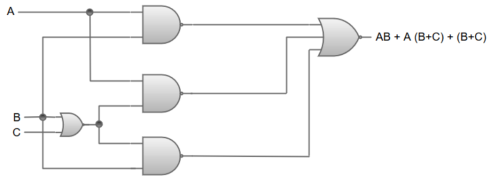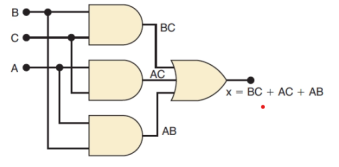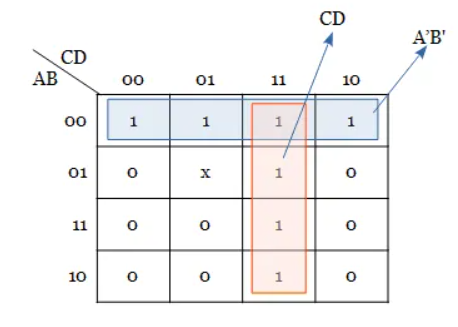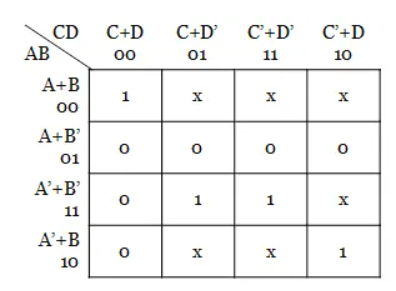Unit - 1
Fundamentals of Digital Circuit
Q1) Subtract 134 from 168.
A1) 168-134 = 168 + (-134)
Binary representation of 168= 1010 1000
Binary representation of 134= 1000 0110
Binary representation of -134= 0111 1001
[Because 1’s complement represents the negative magnitude of a binary number]
168 + (-134) = 1010 1000 + 0111 1001 = 10010 0001
As a carry bit is present, 1 will be added to the result and it represents that the result is positive. 0010 0001 + 1 = 0010 0010
Decimal representation of 0010 0010 is 34.
168-134=34; hence the result is correct.
Q2) Subtract 168 from 134.
A2) 134-168 = 134 + (-168)
Binary representation of 134= 1000 0110
Binary representation of 168= 1010 1000
Binary representation of -168= 0101 0111
[Because 1’s complement represents the negative magnitude of a binary number]
134 + (-168) = 1000 0110 + 0101 0111=1101 1101
As a carry bit is absent, 1’s complement of this value will be the final result and absence of carry bit represents that the result is negative.
1’s complement of 1101 1101 = 0010 0010
Decimal representation of 0010 0010 is 34.
As carry bit is absent the result is negative i.e -34 134 -168= -34; hence the result is correct.
Q3) Subtract 96 from 118.
A3) 118-96 = 118 + (-96)
Binary representation of 118= 0111 0110
Binary representation of 96= 0110 0000
Here 2’s complement represents the negative magnitude of a binary number.
Hence 2’s complement of 96 represents -96.
So -96= 1001 1111 118 + (-96) = 0111 0110 + 1001 1111=10001 0101
As a carry bit is present, 1 will be added to the result and presents of carry bit represents that the result is positive. 0001 0101+ 1= 0001 0110
Decimal representation of 0001 0110 is 22.
As carry bit is present the result is positive.
Q4) Subtract 118 from 96.
A4) 118-96 = 96 + (-118)
Binary representation of 96= 0110 0000
Binary representation of 118= 0111 0110
Here 2’s complement represents the negative magnitude of a binary number.
Hence 2’s complement of 118 represents -118.
So -118= 1000 1010 96 + (-118) = 0110 0000 + 1000 1010 1110 1010
As a carry bit is absent, 2’s complement of this value will be the final result and absence of carry bit represents that the result is negative.
2’s complement of 1110 1010 = 0001 0110
Decimal representation of 0001 0110 is 34. As carry bit is absent the result is negative i.e -34
Q5) Calculate the Decimal Equivalent of binary number 101112
A5) Calculating the Decimal Equivalent of binary number −
Step | Binary Number | Decimal Number |
Step 1 | 101012 | ((1 × 24) + (0 × 23) + (1 × 22) + (1 × 21) + (1 × 20))10 |
Step 2 | 101012 | (16 + 0 + 4 + 2 + 1)10 |
Step 3 | 101012 | 2310 |
Q6) Calculate Decimal Equivalent of 125758?
A6) Calculating Decimal Equivalent −
Step | Octal Number | Decimal Number |
Step 1 | 125758 | ((1 × 84) + (2 × 83) + (5 × 82) + (7 × 81) + (5 × 80))10 |
Step 2 | 125758 | (4096 + 1024 + 320 + 56 + 5)10 |
Step 3 | 125758 | 550010 |
Q7) Calculate Decimal equivalent of 19FDA16?
A7) Hexadecimal Number: 19FDA16
Calculating Decimal Equivalent −
Step | Hexadecimal Number | Decimal Number |
Step 1 | 19FDA16 | ((1 × 164) + (9 × 163) + (F × 162) + (D × 161) + (A × 160))10 |
Step 2 | 19FDA16 | ((1 × 164) + (9 × 163) + (15 × 162) + (13 × 161) + (10 × 160))10 |
Step 3 | 19FDA16 | (65536 + 36864 + 3840 + 208 + 10)10 |
Step 4 | 19FDA16 | 10645810 |
Q8) Calculate Binary Equivalent of 2710?
A8) Decimal Number: 2710
Calculating Binary Equivalent −
Step | Operation | Result | Remainder |
Step 1 | 27 / 2 | 13 | 1 |
Step 2 | 13 / 2 | 6 | 1 |
Step 3 | 6 / 2 | 3 | 0 |
Step 4 | 3 / 2 | 1 | 1 |
Step 5 | 1 / 2 | 0 | 1 |
Hence, the remainders are arranged in the reverse order and we get:
Decimal Number − 2710 = Binary Number − 110112.
Q9) Calculate Decimal Equivalent of 111102
A9) Binary Number − 111102
Calculating Decimal Equivalent −
Step | Binary Number | Decimal Number |
Step 1 | 111102 | ((1 × 24) + (1 × 23) + (1 × 22) + (1 × 21) + (0 × 20))10 |
Step 2 | 111102 | (16 + 8 + 4 + 2 + 0)10 |
Step 3 | 111102 | 3010 |
Binary Number − 111102 = Decimal Number − 3010
Q10) Calculate Binary equivalent of 268?
A10) Octal Number − 268
Calculating its Binary Equivalent −
Step 1 – Converting octal to Decimal
Step | Octal Number | Decimal Number |
Step 1 | 268 | ((2 × 81) + (6 × 80))10 |
Step 2 | 268 | (16 + 6 )10 |
Step 3 | 268 | 2210 |
Octal Number − 268 = Decimal Number − 2210
Step 2 − Converting Decimal to Binary
Step | Operation | Result | Remainder |
Step 1 | 22 / 2 | 11 | 0 |
Step 2 | 11 / 2 | 5 | 1 |
Step 3 | 5 / 2 | 2 | 1 |
Step 4 | 2 / 2 | 1 | 0 |
Step 5 | 1 / 2 | 0 | 1 |
Decimal Number − 2210 = Binary Number − 101102
Octal Number − 268 = Binary Number − 101102
Q11) Find octal equivalent of 101012
A11) Binary Number − 101012
Its Octal Equivalent −
Step | Binary Number | Octal Number |
Step 1 | 101012 | 010 101 |
Step 2 | 101012 | 28 58 |
Step 3 | 101012 | 258 |
Binary Number − 101012 = Octal Number − 258
Q12) Find binary equivalent of 258
A12) Octal Number − 258
Its Binary Equivalent −
Step | Octal Number | Binary Number |
Step 1 | 258 | 210 510 |
Step 2 | 258 | 0102 1012 |
Step 3 | 258 | 0101012 |
Octal Number − 258 = Binary Number − 101012
Q13) Find hexadecimal equivalent of 101012
A13) Binary Number − 101012
Its hexadecimal Equivalent −
Step | Binary Number | Hexadecimal Number |
Step 1 | 101012 | 0001 0101 |
Step 2 | 101012 | 110 510 |
Step 3 | 101012 | 1516 |
Binary Number − 101012 = Hexadecimal Number − 1516
Q14) Find binary equivalent of 1516
A14) Hexadecimal Number − 1516
Its Binary Equivalent −
Step | Hexadecimal Number | Binary Number |
Step 1 | 1516 | 110 510 |
Step 2 | 1516 | 00012 01012 |
Step 3 | 1516 | 000101012 |
Hexadecimal Number − 1516 = Binary Number − 101012
Q15) Simplify the Boolean function, f = p’qr + pq’r + pqr’ + pqr
A15) Given
f = p’qr + pq’r + pqr’ +pqr.
In first and second term r is common and in third and fourth terms pq is common.
So, taking out the common terms by using Distributive law we get,
⇒ f = (p’q + pq’)r + pq(r’ + r)
The terms present in first parenthesis can be simplified by using Ex-OR operation.
The terms present in second parenthesis is equal to ‘1’ using Boolean postulate we get
⇒ f = (p ⊕q)r + pq(1)
The first term can’t be simplified further.
But, the second term is equal to pq using Boolean postulate.
⇒ f = (p ⊕q)r + pq
Therefore, the simplified Boolean function is f = (p⊕q)r + pq
Q16) Simplify the Boolean function, f = p’qr + pq’r + pqr’ + pqr
A16) Using the Boolean postulate, x + x = x.
Hence, we can write the last term pqr two more times.
⇒ f = p’qr + pq’r + pqr’ + pqr + pqr + pqr
Now using the Distributive law for 1st and 4th terms, 2nd and 5th terms, 3rdand 6th terms we get.
⇒ f = qr(p’ + p) + pr(q’ + q) + pq(r’ + r)
Using Boolean postulate, x + x’ = 1 and x.1 = x for further simplification.
⇒ f = qr(1) + pr(1) + pq(1)
⇒ f = qr + pr + pq
⇒ f = pq + qr + pr
Therefore, the simplified Boolean function is f = pq + qr + pr.
Hence, we got two different Boolean functions after simplification of the given Boolean function. Functionally, these two functions are same. As per requirement, we can choose one of them.
Q17) Find the complement of the Boolean function,
f = p’q + pq’.
A17) Using DeMorgan’s theorem, (x + y)’ = x’.y’ we get
⇒ f’ = (p’q)’.(pq’)’
Then by second law, (x.y)’ = x’ + y’ we get
⇒ f’ = {(p’)’ + q’}.{p’ + (q’)’}
Then by using, (x’)’=x we get
⇒ f’ = {p + q’}.{p’ + q}
⇒ f’ = pp’ + pq + p’q’ + qq’
Using x.x’=0 we get
⇒ f = 0 + pq + p’q’ + 0
⇒ f = pq + p’q’
Therefore, the complement of Boolean function, p’q + pq’ is pq + p’q’.
Q18) Using Boolean algebra techniques, simplify this expression: AB + A(B + C) + B(B + C)
A18)
Step 1: Apply the distributive law to the second and third terms in the expression, as follows: AB + AB + AC + BB + BC
Step 2: Apply rule 7 (BB = B) to the fourth term. AB + AB + AC + B + BC
Step 3: Apply rule 5 (AB + AB = AB) to the first two terms. AB + AC + B + BC
Step 4: Apply rule 10 (B + BC = B) to the last two terms. AB + AC + B
Step 5: Apply rule 10 (AB + B = B) to the first and third terms. B+AC At this point the expression is simplified as much as possible.


Fig: Implementation using gates
Q19) Design a logic circuit that has three inputs, A, B, and C, and whose output will be HIGH only when a majority of the inputs are HIGH.
A19)
Step 1. Set up the truth table. On the basis of the problem statement, the output x should be 1 whenever two or more inputs are 1; for all other cases, the output should be 0

Fig: Truth Table with AND terms
Step 2. Write the AND term for each case where the output is a 1. There are four such cases. The AND terms are shown next to the truth table. Again, note that each AND term contains each input variable in either inverted or noninverted form.
Step 3. Write the sum-of-products expression for the output. x =  BC + A
BC + A C + AB
C + AB + ABC
+ ABC
Step 4. Simplify the output expression.
This expression can be simplified in several ways. Perhaps the quickest way is to realize that the last term ABC has two variables in common with each of the other terms. Thus, we can use the ABC term to pair with each of the other terms. The expression is rewritten with the ABC term occurring three times:
x =  BC + A
BC + A C + AB
C + AB + ABC + ABC + ABC
+ ABC + ABC + ABC
Factoring the appropriate pairs of terms, we have
x = BC ( + A) + AC (
+ A) + AC ( + B) + AB (
+ B) + AB ( + C) Each term in parentheses is equal to 1, so we have x = BC + AC + AB
+ C) Each term in parentheses is equal to 1, so we have x = BC + AC + AB
Step 5. Implement the circuit for the final expression. This expression is implemented in Figure. Since the expression is in SOP form, the circuit consists of a group of AND gates working into a single OR gate.

Fig: Implementation using gates
Q20) Simplify the Boolean function with don’t care conditions Y(A, B, C, D) = ∑ m (1, 3, 7, 11, 15) + d (0, 2, 5).
A20)
Step 1: The given function has four variables and hence 24 = 16 cells K-map is necessary to minimize the expression.
Step 2: Plotting of k-map.

Step 3: Here, instead of pairing cells, quad group can be formed. To form a quad group of 1s, the don’t care outputs of cells 0, 2 are replaced by 1s and grouping is done. The remaining don’t care outputs are left alone or replaced by 0s.

Hence, from the K-map, the simplified output expression is Y = A’B’ + CD
Q21) Simplify the Boolean function with don’t care conditions Y (A, B, C, D) = Π M (4, 5, 6, 7, 8, 12) + d (1, 2, 3, 9, 11, 14).
A21)
Step 1: The given function has four variables and hence 24 = 16 cells K-map is necessary to minimize the expression.
Step 2: Plotting of k-map.

Step 3: Here, instead of pairing cells, quad group can be formed. To form a quad group of 0s, the don’t care outputs of cells 0, 2 are replaced by 0s and grouping is done. The remaining don’t care outputs are left alone or replaced by 1s.

Hence, from the K-map, the simplified output expression is Y = (A+B’) (A’+C+D)